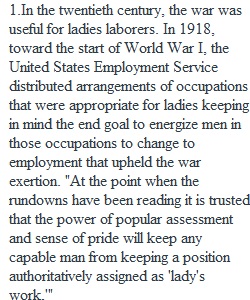


Q Read the following article and answer the questions at the end. Linking Research to Life: Unequal Pay for Equal Work Despite the progress that women have made in American society over many decades, there remains one area where gender differences are so entrenched they almost seem normal: pay equity. In the United States, the first law regarding pay equity was passed by Congress in 1963. Forty-six years later, in 2009, President Obama signed the Lilly Ledbetter Fair Pay Act, showing clearly that the problem of pay inequity still exists. In their comprehensive and insightful analysis of the continuing gap between men’s and women’s paychecks for the same work, Dey and Hill (2007) make a clear case that much needs to be done, and now. Why? Consider this: On average, a woman earns on average of about $0.81 for every $1.00 a male earns (Bureau of Labor Statistics, 2013c). This is even after controlling for such important variables as occupation, hours worked, parenthood, and other factors associated with pay. Although the pay differential has improved over the past few decades, the differential remains significant and unfair. What if women choose a college major that is associated with high-paying jobs, such as those in science, technology, engineering, and mathematics? Will that help reduce the pay differential? No. Choosing a traditionally “male-dominated” major will not solve the problem alone. For example, women in mathematics occupations earn only about $0.76 for every $1.00 a male mathematics graduate earns. A woman is also significantly disadvantaged regarding the division of labor at home if she is married to or living with a man, as we will consider later in this chapter. Despite decades of trying to get men to do more of the housework and childcare tasks, little has changed in terms of the amount of time men actually spend on these tasks. In effect, this means that women have two careers—one in the workplace and the other at home. In addition, if a college-educated woman stays at home to care for a child or parent and then decides to go back to work, her return to the workforce will be at a lower salary than it would have been otherwise. So what can be done about pay inequity? First, we must recognize that it exists; only then can other steps be taken. Women and men deserve to be treated fairly and paid the same for the same work. But that’s not enough—laws against it have been on the books for years. Workplaces must change by making accommodations for people who take care of a child or parent and carefully analyzing salary policies. Making this a reality will take a cooperative effort by everyone. ________________________________________ 1. Discuss the history of pay disequity between men and women in the United States. Make sure to cite important events and trends that have occurred, noting where progress has been made and has stalled. 2. Your daughter, Emma, tells you that she is going to major in engineering in college. When you ask her why she's made that choice, she says: "I don't really like engineering, but I thought that a high-tech job like that would give me a better chance to earn as much as a man will make in the same job." Based on your reading of this chapter, is Emma making a good choice? Why or why not? 3. Identify some reasons why a working woman who is married to or living with a man is particularly disadvantaged. 4. ou are placed in charge of a Congressional oversight committee charged with formulating a strategy for closing the wage gap that exists between men and women. Outline the steps you would suggest to your committee to accomplish this goal. PreviousNext
View Related Questions